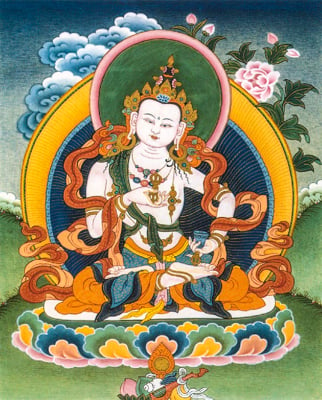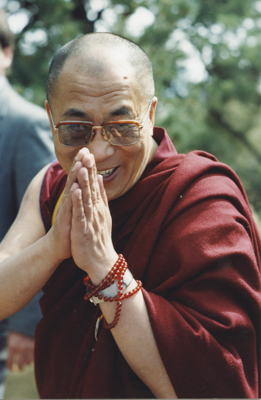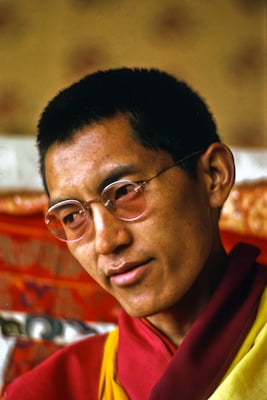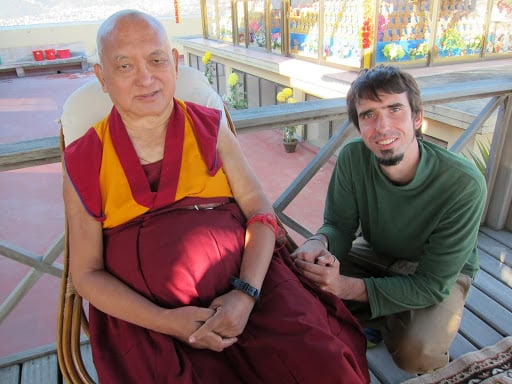Dear LYWA friends and supporters,
We are delighted to bring you our March e-letter. Thank you so much for subscribing to it. We have many new teachings and advices on our website to share with you.
Teachings from Tenzin Ösel Hita
We have just posted the audio and transcripts from two talks given by Tenzin Ösel Hita, who is the recognized reincarnation of FPMT founder Lama Yeshe. The first talk, How to Understand Our Reality from the Universal Point of View was given in February 2013 at Choe Khor Sum Ling Study Group in Bangalore, India. We've provided a link on our website to the video of this talk which was posted on YouTube.
We have also posted a talk Ösel gave at Amitabha Buddhist Center in Singapore, November 2012 on Satisfaction and Challenging Your Limits. The second part of the talk includes a question and answer session where Ösel talks about his time as a monk and his vision for how to be of most benefit to others in the future.
You can watch an interview with His Holiness the Dalai Lama where he talks about the recognition of Ösel as the reincarnation of Lama Yeshe. And, you can find more information about Ösel on the FPMT website.
New Advice from Lama Zopa Rinpoche
Many new advices were added to Rinpoche's Online Advice Book in the months of February and March. These include advice on Preliminary Practices, and Advice for New Students. Rinpoche also offered advice on Eliminating Paralysis which was written down by Rinpoche on an iPad, with his left hand and one finger, three days after manifesting paralysis in April 2011.
Rinpoche also offered a long advice to a student who was diagnosed with cancer, who wrote to request prayers and practices. In his reply Rinpoche said:
"The best thing is that the ripening of negative karma can be used for happiness, and not just for happiness of this life, but also for future lives, liberation from samsara and enlightenment. It can be used for ultimate enlightenment. It’s an essenceless thing, actually, but if you can experience it with bodhicitta, it becomes the cause of enlightenment and liberates oceans of hell beings, hungry ghosts, animals, humans, suras and asuras from samsara. It grants the greatest happiness and becomes most meaningful."
You can view a list of all new advices posted in February and March.
What Else is New on Our Website Listen online to Lama Zopa Rinpoche's Teaching on Purification. Rinpoche gave these teachings before a Vajrasattva initiation at Jinsiu Farlin Center in Taiwan in 1994. In these teachings Rinpoche explains the benefits of ending our non-virtuous activities and purifying our negative karma.
Listen online to Lama Zopa Rinpoche's Teaching on Purification. Rinpoche gave these teachings before a Vajrasattva initiation at Jinsiu Farlin Center in Taiwan in 1994. In these teachings Rinpoche explains the benefits of ending our non-virtuous activities and purifying our negative karma.
You can also read excerpts from Rinpoche's teachings at the 7th Lamrim Course at Kopan Monastery in November-December 1974. Selections include:
- How to Listen to the Teachings
- Observing Karma
- Taking the Essence of the Perfect Human Rebirth
- Offerings to Holy Objects, which is also our e-letter teaching below.
All were lightly edited by Sandra Smith. You can also read the entire course online, or download it as a pdf.
If you are interested in receiving email notifications about new teachings soon after they are posted, you can sign up for email alerts on our website. You can choose to receive alerts only for teachings by particular teachers or on particular topics.
Teachings from Great Lamas Read a teaching by His Holiness the Dalai Lama prior to a ceremony for Generating the Mind of Enlightenment, given in New Jersey, USA, in May 1998. Lightly edited by Sandra Smith.
Read a teaching by His Holiness the Dalai Lama prior to a ceremony for Generating the Mind of Enlightenment, given in New Jersey, USA, in May 1998. Lightly edited by Sandra Smith.
We have also just posted a commentary given by Geshe Rabten on the Praise to Manjushri in Dharamsala, India, in June, 1975. Translated by Gonsar Rinpoche and edited by Sandra Smith and Ven. Gyalten Lekden. This teaching is now posted on our companion website TeachingsFromTibet.com.
Big Love, Lama Yeshe
Work is progressing on the authorized biography of Lama Yeshe Big Love. The editing is done, and we are now in the stage of selecting images for the book. Visit our Big Love blog to read excerpts from early chapters and view some of the images to be included in the book.
Lama Yeshe was recently published on Elephant Journal, an online publication. Click to read the article and help us achieve a featured placement!
We leave you with an excerpt from Rinpoche's teachings at Kopan Monastery in 1974 on how to make offerings to holy objects. Thank you so much for helping us to make these precious teachings freely available far and wide. We couldn't do it without your support.
Much love,
Nick Ribush
Director
This Month's Teaching: Offerings to Holy Objects
 Making offerings to the holy objects doesn’t depend on them actually receiving material things. Ordinary people actually want to receive material things in their hands, but it is not like this for the holy objects; it is completely different for them. Ordinary people, such as kings, want to receive material things in their hands. If the other person is just mentally dedicating and renouncing, that is not sufficient for ordinary people —that does not make them happy.
Making offerings to the holy objects doesn’t depend on them actually receiving material things. Ordinary people actually want to receive material things in their hands, but it is not like this for the holy objects; it is completely different for them. Ordinary people, such as kings, want to receive material things in their hands. If the other person is just mentally dedicating and renouncing, that is not sufficient for ordinary people —that does not make them happy.
What makes ordinary people happy is actually physically giving them material things in the hand. Ordinary beings like the king are not happy with mentally transformed offerings, because they don’t get anything. However, for the holy objects, the enlightened beings, the actual material things don’t have to be received in their hands, the offerings don’t have to be like that. It’s completely different from ordinary people.
Offering mainly means renouncing from your mind, no matter where the object is or whether it is with you, for instance, your body. Making offerings to holy objects doesn’t have to be like making offerings to ordinary people, being with them or something. Offering is also called puja by Indians, but actually offering or puja means pleasing the gurus, the enlightened beings; that is the actual meaning of puja. If it doesn’t please them, it doesn’t become puja. Anyway, there is so much to talk about.
One fundamental thing that pleases the enlightened beings is renouncing attachment. That is the fundamental thing that pleases the holy objects—renouncing attachment, anger and ignorance. So this is the fundamental thing and then, according to the person’s practice, pleasing the gurus, the enlightened beings, the holy objects, has a higher meaning, there is a higher practice. Anyway, we are talking about the fundamental thing. According to Vajrayana practice there is a higher way to understand this, to practice, to please the holy objects—there is a transcendental way, a higher way.
Usually when we have memories of past things—of friends, of what we did and things that we had—when we have memories, even though we don’t have the actual thing at the present time, even by having them mentally, we get attached. By seeing a picture of them we get attached. So, how does this become offering? How does this help to purify our own negativity and our negative karma? How do we stop and purify the negative karma that we have been collecting from previous lifetimes? How can making offerings help us to receive enlightenment?
Being attached to these pictures that come into the mind creates negative karma, it reflects again in the mind, with attachment. It is involved with craving. However, when we make mentally transformed offerings, that means renouncing the attachment and the craving for those beautiful objects of the senses. Also, the objects, such as flowers, smells, and incense, have to be visualized as beautiful as possible. If you can visualize them as best as possible then you create good karma. There are also beautiful goddesses. Another way of imagining the goddesses is to visualize female human beings carrying different offerings and playing different music. As much as you can visualize them as beautiful, that much you create good karma, because you are not visualizing with attachment to make them arise; you are renouncing attachment. You are making offerings to renounce attachment, in order for it to be the opposite of the action of using things with attachment. This is the practice of trying to become the opposite of attachment; it is the remedy to attachment.
So anyway, transform the offerings like this, instead of getting attached to these objects, thinking, “I like this,” “I want this,” with the mind completely sinking in the object, completely absorbing in the object. Instead of that, without letting attachment arise, completely dedicate that object to the holy objects you are visualizing—Guru Shakyamuni Buddha, surrounded by infinite buddhas and bodhisattvas. Dedicate to them.
While you visualize, if there is attachment arising, think, “I am making offerings to the holy objects. These offerings belong to the holy objects, so if I am attached to these things, it is nonsense. I cannot be attached to these things, as they are offered to the holy objects.” Think like this.
When we give—whether it is a physical offering or a mental offering—we should have less attachment to the offering. Perhaps if there is no wish or no thought to offer these things to Buddha, to the enlightened beings, to create good karma, then we won’t do the action. Without the wish, without the thought, we don’t try, we don’t put effort into that, so that is not greed, it is not attachment. There is a difference. Just wishing doesn’t mean we have attachment.
However, for the physically offered or mentally transformed offerings, if there is no attachment to those offerings, that much the offering is pure. So the main purpose of making offerings is to lose attachment. Mentally transforming the offerings is beneficial, because this is a method to purify or lose the attachment. Also, memories and pictures of other things come into the mind because of the attachment to the object. It is the same thing with the physical offerings, the material offerings—mainly we make offerings to lose attachment. So the actual thing, the actual offering is renouncing attachment. This is the fundamental thing that pleases the holy objects. How does this please the holy objects? Why does the renouncing mind please the holy objects? This is not their negative mind, this is my negative mind, so why are they pleased by me renouncing my negative mind?
The whole reason is this. The holy objects, the enlightened beings, even the bodhisattvas, are always concerned about other sentient beings’ suffering the whole time; they are always concerned to release sentient beings from suffering the whole time—day and night. They always have infinite compassion for each of the sentient beings. They always spontaneously wish to release sentient beings from suffering, to release them from all their negative karma and delusions, all their wrong conceptions. Their main wish is to release sentient beings from suffering and wrong conceptions and for them to receive enlightenment. Usually they wish like that, but from our side we often create the cause of suffering, we often keep ourselves away from the boundless state, by continuously creating the cause of samsara. Our work is the opposite of what they wish for all the time.
This time what we do is according to what they wish for, so it becomes harmonious, it becomes the same thing. This work that they wish for is enlightening oneself, purifying oneself. So that’s how, mainly because of their infinite compassion wanting oneself and all sentient beings to be released from all suffering and to reach enlightenment, renouncing the negative mind pleases them. So, mentally transform the offerings.
Kyabje Lama Zopa Rinpoche gave this teaching at Kopan Course #7 in 1974. This is an excerpt from Day 21, Meditation Two: Part II: Refuge. Lightly edited by Sandra Smith. Visit the FPMT website for more information about offering to holy objects, and Lama Zopa Rinpoche's Advice Book for advice regarding Holy Objects.






























